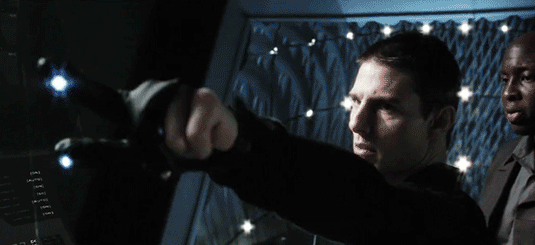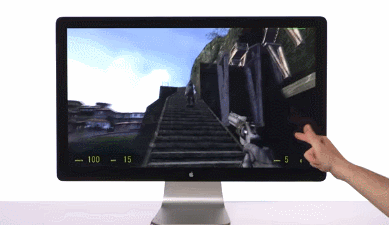Have you ever wished you’d come home one day and vividly move your hands around in a choreographic way and shout “In the nameth of häagen-dazs, turneth on the heateth and checketh the cupboards f’r pringles crisps!“? Well I have.

Gesture control interfaces might not be the type of visual communication you would imagine, just like a poster or a booklet, but personally I believe most of our visual communication will be based on that kind of technology in the future. Of course books and posters will still exist but in the same way home phones do now.
Sci-fi films have helped us create a common expectation of this type of future technology and re-occurrent attempts in integrating information tailored on each person (e.g. wearables, Goggle Glasses) has given us a taste of what the challenges will be.
In the future I foresee technology and visual communication will be combined in such way we will probably view as a new art form as well. Something like the first screenings of motion pictures were like which made cinema end up being the Seventh Art (Ricciotto Canudo, 1908) . It sounds crazy now and I could do myself a favor and choose a car advertisement for the exercise but talking about the future we have to think outside the box, but with the box as a reference point.
People are fascinated by this new way of tech-communication. It might be the fact that it’s an invisible interface that will exist in our environment, much like wifi today, or because the gesture motions make it look like magic.

One difficulty is to try to interpret human intent. So far for example, we can unlock our smartphones with a customized gesture on the touchscreen, but to do even that we have to ‘train’ our smartphones to recognize our doodle by repeating the pattern so there can be variables of that signature for future reference. Imagine the implication for something similar to gesture interface. We would have to record thousands of different body movements from different people in order to come up with something that might work especially considering the micro-gestures of the human hand.
But let’s say we managed to be successful in the above. We still have to tackle the fact this new visual communication possibility needs an environment it can work in uninterrupted. This means not only we need ‘smart homes’ but also this to extend everywhere else, in every building or open space. That would be a very complex issue.
Lastly, although it seems as it would come natural to us to move around gracefully so we can boil pasta from a distance, the possibility of using it for an extended period of time, let’s say while you work away on your computer, might become daunting and tiring. Few people who have had the chance to use tv sets that have similar technology have complained about the surprising unnatural prolonged gestures they had to make.
But I do believe we will solve the above issues successfully. With the advances of AI and quantum computing, it comes to no surprise to also adopt gesture control. A technology shyly coming to light since the 60’s, it’s still considered in it’s infancy but still with great potential. Imagine the art projects of the future. The interactivity can lead to a new form of art together with the viewer. Maybe then the artist will become more and more insignificant so the artist in all of us can come forward instead. Centuries ago the artwork was commissioned and in many cases the artists were hardly recognized. I believe something similar will happen again but this time because the commissioner or the influencer will be the audience.
In the case of failure, it might be because there could be a collective awakening against the overindulgence of technology in our lives. Only now we learn that the more we depend ourselves and our communication in non face-to-face devices the more we detach ourselves from reality and we become receivers of misinformation. In this case we might go all or nothing, fully emerged in technology even in art form, or back to point zero in a rebellious move. Another reason it might fail is the fact it hasn’t been widely available yet! There is little patience in people’s expectations and it already has disbelievers. And in todays’ -fast, web loving- world, something anticipated that hasn’t become tangible yet is already considered doomed.


SOURCES
- Andrey Kasay. At: https://vimeo.com/andreykasay (Accessed on 11 January 2019)
- (2013) Iron Man II film. At: https://media.giphy.com/media/SLBr5yLzocSYw/giphy.gif (Accessed on 11 January 2019)
- Description of ‘Canudo, Ricciotto, fl 1908, writer, Canudo, Ricciotto, c1908. Senate House Library Archives, University of London. GB 96 MS 507’ on the Archives Hub website, [https://archiveshub.jisc.ac.uk/data/gb96-ms507], (date accessed :11/01/2019)
- The ‘Minority Report reference’. At: https://yipp.nl/blog/31-the_minority_report_reference/ (Accessed on 11 January 2019)
- (2015) Project Soli. At: https://media.giphy.com/media/5nvZyDU2Toe3u/giphy.gif (Accessed on 11 January 2019)
- Leap Motion. At: https://i.gifer.com/M9n1.gif (Accessed on 11 January 2019)

